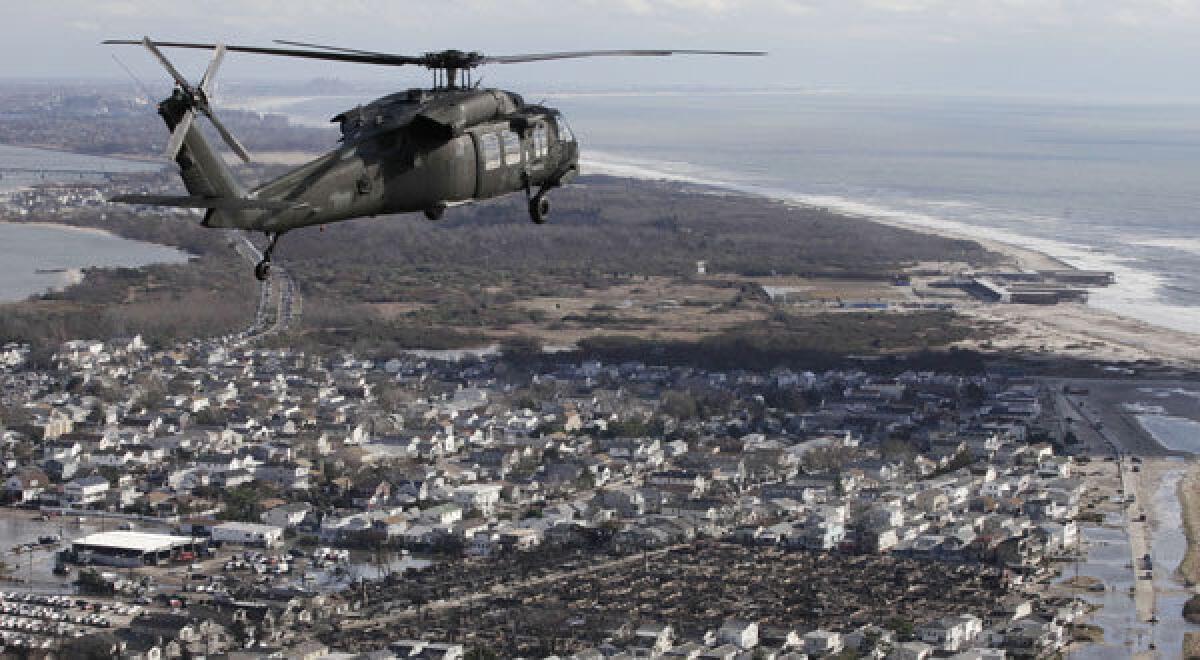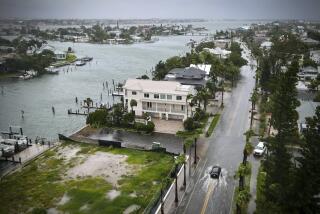Hurricane season 2012 is done: Sandy not ‘major’? So they say

This year’s hurricane season — which officially comes to a close Friday — has proved to be one of the most active on record, with Hurricane Isaac and super storm Sandy wreaking havoc on two coastlines, although both storms, technically, did not meet the definition of “major” hurricanes.
“This year proved that it’s wrong to think that only major hurricanes can ruin lives and impact local economies,” said Laura Furgione, acting director of the National Weather Service.
This season ranks third among the most active since record-keeping began in 1851 with 19 named storms, 10 of them hurricanes — although only one, Michael, was strong enough to be considered a “major” hurricane — and it never made landfall. Sandy was a Category 2, Isaac a Category 1.
PHOTOS: 2012 hurricane devastation
On Thursday, forecasters at the Tropical Meteorology Project at Colorado State University issued a report noting they had “significantly under-predicted named storms and named storm days, while we over-predicted more intense hurricane activity for the entire Atlantic basin.”
Many forecasters low-balled the number of storms this year, expecting winds associated with El Nino to weaken tropical systems through “wind shear,” an effect that tilts them before they can grow taller and strengthen.
“A lot of seasonal forecasters, us included, expected El Nino to develop, which it really didn’t,” said Colorado State forecaster Philip Klotzbach. “This season was really unusual.”
QUIZ: Test your hurricane knowledge
Usually, the Atlantic sees a dozen named storms a season, half of them hurricanes, half of those major storms, according to John Cangialosi, a hurricane specialist at the National Hurricane Center in Miami.
The season also began earlier than usual, with tropical storms Alberto and Beryl arriving before June 1, and tied with the last two years, as well as 1995 and 1887, for the third-most tropical storms on record. There were more storms only in 2005 (28), and in 1933 (21), according to the National Hurricane Center.
This was first season with only one major hurricane in five years, less than what the National Oceanic and Atmospheric Administration had predicted in August: five to eight hurricanes, two to three of them “major,” meaning they rated categories 3 to 5 on the Saffir-Simpson hurricane scale. Michael was a Category 3.
FULL COVERAGE: Hurricane Sandy
The scale was developed in 1971 by civil engineer Herbert Saffir and meteorologist Robert Simpson, then director of the National Hurricane Center, to classify storms based on wind measurements.
According to the National Hurricane Center, a Category 1 hurricane generates “very dangerous winds” of 75 to 95 mph, strong enough to damage roofs, topple trees and power lines.
By contrast, a Category 3 hurricane packs winds of 111 mph or more and can cause “devastating damage” to homes, snapping many trees, blocking roads and leaving areas without water or power for weeks.
Hurricane Isaac was a Category 1 when it made landfall in Louisiana August 28, eventually killing nine people and causing up to $1.5 billion in damages, primarily from flooding associated with heavy rain and storm surge.
Superstorm Sandy, the most powerful storm this season, peaked as a Category 2, weakened and was no longer even a hurricane according to Saffir-Simpson when it made landfall in New Jersey on Oct. 29, killing 125 people across the region and causing $62 billion in damages, making it the second-costliest storm in U.S. history after Hurricane Katrina in 2005, which caused about $128 billion in damages, adjusting for inflation.
Both storms illustrate the danger of judging hurricanes according to their category on the familiar scale, weather experts said.
“Saffir-Simpson scale is solely based on the wind speed,” Cangialosi said. “A lot of people sometimes over-focus on the categories. People are usually taken off guard and think it could be a lot worse. We don’t want you to pay attention to the category. Wind is only one variable that contributes to how high storm surge could be.”
Rainfall is another factor the scale doesn’t account for. Isaac moved slowly over the New Orleans area, dumping rain into already saturated low-lying areas and contributing to flooding.
“We’ve seen more rain with weak storms than strong storms,” Cangialosi said.
Other weather experts fault the scale for being too general.
“There’s a big difference between a weak Category 1 and a Category 2,” said Pat Fitzpatrick, an associate research professor of meteorology at Mississippi State University.
Fitzpatrick said the scale might be more useful if it allowed for more gradations in the severity of hurricanes — like the scale for the magnitude of earthquakes.
To supplement the Saffir-Simpson scale, forecasters at the National Oceanic and Atmospheric Administration now also measure the chance of storm surge reaching certain levels, called the “probabilistic surge,” and issue it along with a storm watch or warning, Cangialosi said. Forecasters also urge emergency managers to take the surge predictions into account.
“For Sandy we knew that was going to be a big hazard. There’s been a discussion about how to warn the public and better measure these hazards rather than the direct track and category,” Cangialosi said.
Unlike the track of a hurricane or wind speed, storm surge varies greatly depending on the area a storm is approaching and can be difficult to predict, according to Brian McNoldy, a senior researcher at the University of Miami’s Rosenstiel School of Marine and Atmospheric Science.
“There isn’t really a single scale for storm surge right now because there’s so many different factors,” he said, including the direction of the storm’s approach, where it makes landfall and ground cover.
“Some places are a lot more surge-prone than others,” he said, as we saw this season when Isaac and Sandy struck areas in southern Louisiana and the mid-Atlantic, “some of the most surge-prone in the country.”
McNoldy said a Category 1 “might not rip off your roof, but it will flood the whole first floor of your house.”
“Hopefully it’s something people can remember—just because it’s a Category 1 doesn’t mean it’s weak. Things like rainfall and storm surge aren’t that closely related to how intense the wind is,” he said, and when it comes to storm surge, “There is no such thing as a weak hurricane.”
ALSO:
Ecoterrorism suspect surrenders at Canadian border
New Mexico traffic stop was case of police abuse, lawsuit alleges
George Zimmerman offers signed thank-you cards to raise money
More to Read
Sign up for Essential California
The most important California stories and recommendations in your inbox every morning.
You may occasionally receive promotional content from the Los Angeles Times.









